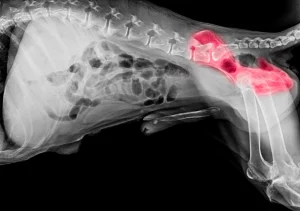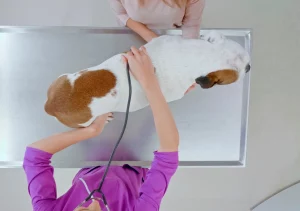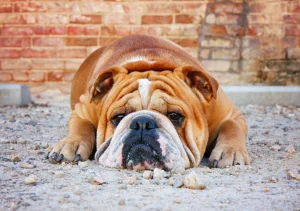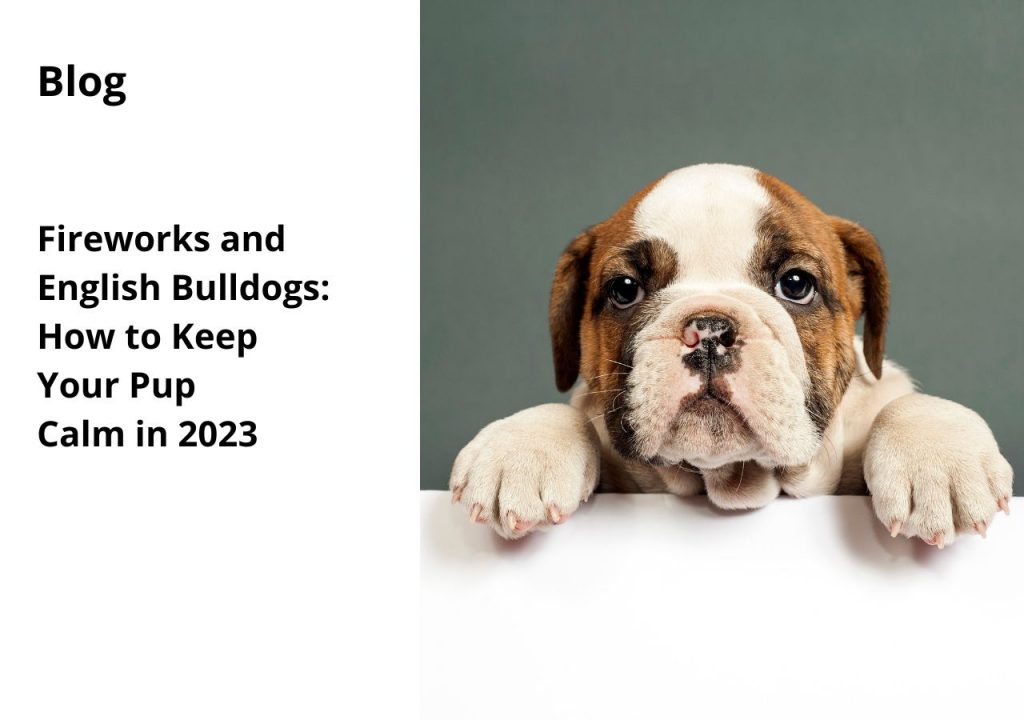Hip dysplasia is a common orthopedic condition that affects many English Bulldogs, causing discomfort, pain, and reduced mobility. It is crucial for owners and breeders to have a comprehensive understanding of hip dysplasia, including its causes, symptoms, diagnosis, and available treatment options!
English bulldog hip dysplasia is one of the most common health issues that these loved pooches can have, and we must know how to help them! So, let’s dive into this specific problem and see what we can do:
What is hip dysplasia in English Bulldogs?

If we want to understand bulldog hip dysplasia better, we need to know how the hip joint actually functions! The hip bone is like a ball that has its own pocket to fit in. The ball bone part is called the femoral head, and the acetabulum, or the pocket, is the place where the hip is connected to the pelvis. In normal doggy hips, the “ball” can easily rotate inside of the “pocket,” and it creates fluid movement of the pelvis and hind legs. When there is a hip dysplasia problem, the joint is not fixated enough; movements are restricted and very painful for our pups.
English bulldogs that suffer from hip dysplasia are born with normal and functional hips, and the problems occur as they grow older due to weak ligaments and bone formations. It is important to catch up on early hip problem signs so that you can react and prevent your pup from experiencing the pain and discomfort that this particular problem can cause!
Are English bulldogs prone to Hip Dysplasia?

Did you know that according to the Orthopedic Foundation for Animals, the rate of hip dysplasia in Bulldogs is the highest among all dog species? In a study that was done for some years, in 844 tested bulldogs, 71% had hip dysplasia or some similar problems! Why is this percentage so high? Well, the answer is hidden in the English bulldogs’ specific genetics!
English bulldogs have started as a bit taller and more masculine, with normal snout length, a bit bigger ears, and fewer wrinkles. In time and breeding changes, we got the British bullies that we adore for their specific looks and great personalities, but with a few genetic quirks and problems. Among them, there are hip problems that can be quite painful and stressful!
The symptoms and signs of hip dysplasia in English Bulldogs

Common symptoms of hip dysplasia are not hard to spot, but the tricky part is that when the signs are there, the problem is probably already painful for your pup. Here are some of the hip dysplasia symptoms:
- Difficulty in getting up or lying down
- Limping
- Decreasing activity levels
- Bunny hop walks
- Painful whimpers while the dog is moving the problematic leg
- Stumbling and falling
- Frog sitting position
- Loss of hip and thigh muscles
All of these symptoms are very uncomfortable, and you will notice the overall behavioral changes in your pup. In some cases, your English bulldog may even show signs of aggression caused by pain, and it can start losing sleep and having potty problems and other issues!
Hip Dysplasia diagnostic tests
To confirm a diagnosis, your veterinarian will perform a physical examination of your Bulldog’s hips. They may also recommend diagnostic tests like X-rays or joint fluid analysis. Don’t worry; the diagnostics are not very invasive, and they will help the veterinarian determine in which state are the hips of your doggy friend!
Grading systems for hip dysplasia

Veterinarians often use grading systems, ranging from mild to severe, to classify the severity of hip dysplasia. The grades help determine the appropriate treatment plan and management strategies for your bulldog and their hip problems!
How can you treat hip dysplasia?
The best treatment for hip dysplasia in English bulldogs will be recommended by your veterinarian, but we can give you a little insight in what are your options:
Non-surgical treatments
If the hip problems are not severe, then your veterinarian may recommend some of the treatments that do not include surgeries or invasive procedures. The very first step to solving these problems is to make a good treatment plan and stick to it! Your veterinarian will consider factors like your Bulldog’s age, the grading system for hip dysplasia, and their overall health and make a plan that will give the best results. That plan can include:
Medication treatment
Medications for hip dysplasia are meant to ease the pain and soothe the inflammation! The Veterinarian may prescribe medications such as nonsteroidal anti-inflammatory drugs (NSAIDs) or joint supplements. This kind of treatment can help reduce the problems, and in combination with some exercises and physical therapy, your pup can lead a happy and healthy life!
Physical therapy treatment
Physical therapy and rehabilitation can work wonders for Bulldogs with hip dysplasia. Techniques like hydrotherapy, gentle exercises, and massage can help strengthen the surrounding muscles, improve joint stability, and increase mobility. This type of treatment can also ease the pain and help your bulldog lead a happier life.
Weight management and exercise modification
Maintaining a healthy weight is very important for Bulldogs with hip dysplasia. Actually, since the English bulldogs are prone to being overweight, a healthy diet is mandatory no matter the hips!
Your vet might recommend a weight management plan and modifications to exercise routines, like low-impact activities and controlled playtime.
Surgical treatments for hip dysplasia

In severe situations when there are no other treatments available, hip surgery is needed, and your vet will recommend it. There are several surgeries that can be done depending on the grading score of the problem:
Total Hip Replacement (THR)
One of the most effective surgical treatments for hip dysplasia in English Bulldogs is total hip replacement. This procedure is based on replacing the damaged joint with an artificial one, allowing your furry friend to regain pain-free movement.
Triple Pelvic Osteotomy (TPO)
Triple pelvic osteotomy is another surgical option that aims to correct the underlying anatomical abnormalities causing hip dysplasia. It involves cutting and repositioning the pelvic bones to improve the hip joint’s stability and function.
Femoral Head Ostectomy (FHO)
Femoral head ostectomy is a surgical procedure where the femoral head (the ball-shaped top part of the thigh bone) is removed. Without the femoral head, the dog’s hip joint no longer rubs together, reducing pain and allowing the muscles to support the joint in the right way!
English bulldog hip dysplasia surgery cost
Hip dysplasia surgery for English Bulldogs can be quite pricey, ranging from $1,500 to $4,000 on average. However, keep in mind that this is just an estimate, and price can vary depending on various factors, such as the severity of your dog’s condition, location, and the experience of the veterinarian performing the surgery. You also shouldn’t forget to factor in additional costs like pre-surgery consultations, post-operative care, and any required medications or therapy sessions. It’s important to explore all your options and consult with different specialists to find the best price without compromising your pup’s health and well-being!
How to prevent hip dysplasia in English bulldogs?
When it comes to preventing hip dysplasia in English Bulldogs, there are a few things you can do!
- First off, it’s important to choose a reputable breeder who focuses on breeding dogs with healthy hips. This way, you’re starting with a good genetic foundation.
- Secondly, make sure your Bulldog maintains a healthy weight. A few extra pounds can put more stress on their joints and increase the risk of developing hip dysplasia.
- Regular exercise is also crucial to keep those hip muscles strong and supportive. However, avoid high-impact activities like jumping or intense running that could potentially damage the joints further.
- Providing proper nutrition and supplements may promote joint health as well. Plus, consider using orthopedic dog beds and providing soft surfaces for your Bulldog to lie on. This simple act can help to reduce pressure on their hips while they rest.
By taking these precautions, you can give your furry friend the best chance at avoiding hip dysplasia and living a happier, more comfortable life!
How long can a dog live with hip dysplasia?

While there is no definitive answer to how long a dog can live with hip dysplasia, many factors come into play. The severity of the condition, age, health, and management strategies all influence a dog’s life expectancy. With proper care and intervention, dogs with mild cases of hip dysplasia can have a good quality of life for several years!
The lifespan of English bulldogs is about 10 to 13 years, and even the pups with hip dysplasia can have a long and happy life! Especialy if you take good care of them and don’t miss out on regular vet checkups!
If your English bulldog has this complicated and tricky condition, try to make their life a bit easier! Make your home a hip-dysplasia-friendly environment by providing orthopedic comfy doggy beds. You can also install some ramps instead of stairs to help your Bulldog navigate elevated surfaces. Use some non-slip flooring covers to prevent accidents. Creating a comfortable and safe space for them can greatly improve their quality of life. In conclusion, hip dysplasia is a challenging condition that can significantly impact the well-being of English Bulldogs, but with some treatments, a bit more care, and lots of love, it can all be less stressful!




Pingback: What Is A Miniature English Bulldog? Guide & Top Facts To Know
Pingback: Brindle English Bulldog: Health, Care & Tips For Owners
Pingback: What Are Lilac English Bulldogs? Top 7 Facts To Know About Them
Pingback: White English Bulldog: Health, Training, and Fun Facts